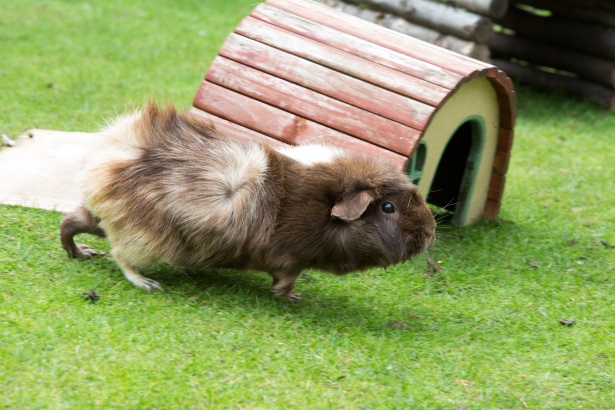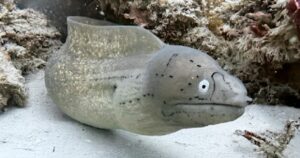Guinea pigs have many interesting behaviors and body language quirks, if you can learn to interpret their behaviors, it will make for a much better relationship with your pet.
In this article, we will talk about 18 strange things guinea pigs do and explain the meanings behind them from spraying urine to biting and dragging their bottom.
(18). Spraying Urine
You have probably noticed that your guinea pig sometimes pees on another guinea pig that’s in the cage with them more often than not, guinea pigs pee on each other to show dominance.
The dominant guinea pig will pee on the subordinate which usually shows its authority, peeing on each other is normal instinctual behavior, it’s just one way your piggies communicate with each other.
Guinea pigs also spray urine when they are marking their territory or when they are annoyed with each other.
(17) Sleeping with open eyes
Guinea pigs often sleep with their eyes open, they sleep with their eyes closed too, but only if they feel very safe and comfortable with their surroundings.
As prey animals, guinea pigs are always on the lookout for predators even when they are sleeping. By sleeping with her eyes open a piggy can detect danger while asleep.
If your guinea pig sleeps with its eyes closed take it as a compliment, your pet feels very safe and secure in its environment.
In addition to that, if you notice that your guinea pigs are standing entirely still almost trance-like then they’re probably asleep.
Another way to know if your guinea pig is really sleeping is to check its whiskers and ears. Guinea pigs dream during the rem stage of sleep and they twitch their ears or whiskers in response to whatever’s happening in their dreams.
(16). Eating Cecotropes
Have you ever seen your guinea pig dip its head down between its hind legs and then come up chewing, well your piggy is eating its cecotropes which are soft feces that are nutrient-rich.
Guinea pigs produce two types of droppings fecal pellets and cecal pellets. Fecal pellets are the waste matter that their body no longer needs sickle pellets however are packed with nutrients that their body hadn’t absorbed.
It’s from these sickle pellets that guinea pigs get the majority of their nutrition, If you see your pet eating their own feces don’t try to stop them as they are actually re-ingesting their cecotropes to get the nutrients they need.
(15). Popcorning
Popcorning is when a guinea pig hops straight up in the air sometimes repeatedly because of the suddenness of the jumping.
This is called popcorning, it usually happens when guinea pigs are very happy and excited, they’re having a good time and literally jumping for joy.
If your guinea pig popcorns when you are around, this is a sign that they are happy to be around you and they love you.
younger guinea pigs are more likely to popcorn because they are full of exuberant young energy. Guinea pig or cavy signs
14. Biting
Guinea pigs are not usually aggressive animals, however, your piggy might fight you if they feel they are threatened or in danger.
This is because their teeth are one of the few natural defensive mechanisms they have, if your guinea pig is very afraid or nervous it may bite you in an attempt to protect itself or to give you a warning that it is not happy.
Keep in mind that aggressive behaviors such as biting can also be a sign of health problems, if your piggy is suddenly aggressive toward you make sure to take them to a vet for a health check.
13. Biting their cage
Guinea pigs’ teeth grow continuously throughout their life, so they need to chew regularly to keep their teeth down to a healthy size.
Chewing on their cage bars could mean they do not have enough things to chew on. Make sure to provide your little pet with enough adequate items such as a daily supply of hay to graze on throughout the day.
Guinea pigs may also chew on their cage bars when they are bored, nervous, or frustrated.
(12). Freezing
Guinea pigs freeze or stand completely still when they feel threatened; usually by loud noise. A sudden movement, a scary smell, or something unfamiliar in their environment.
Their goal is to be as invisible as possible once your guinea pig senses the danger is not present it will unfreeze.
(11). Licking
Bonded guinea pigs show affection by grooming and licking one another, so if your piggy licks or perhaps even tried to nibble you gently they are showing you that they love and care for you.
A guinea pig may also be giving you a lick, simply because you taste good you may have the residue of some yummy treat on your skin and your little pet just wants to lap it up.
(10) Sprawling out
Sprawling is when a guinea pig lies down on its side or belly, this position indicates that your little pet is comfortable and feels safe with its surroundings.
Sprawling is a vulnerable position for a guinea pig because it can take much longer to rise up. In case of danger or predators attack.
So, if your guinea pigs sleep this way when they are next to you then it means they fully trust you and feel comfortable with you.
(9) Scent Marking
If you see your guinea pigs rubbing their bottom across the floor or against cage furnishings, then it is their way of claiming the area as theirs.
Guinea pigs have scent glands slightly above their anal regions that they use to mark their territory when they rub their bottom against something.
A tiny amount of their specific scent is deposited on that area, this spreads their scent throughout their home identifying it as their territory.
We can’t smell the scent and there is no visible mark but other guinea pigs can easily smell the scent left behind by rubbing, but remember, guinea pigs may also rub their bottom to ease an itch, and a constant drag on can be a sign of anal impaction or leg problems.
In a similar manner to bottom dragging both male and female guinea pigs urinate in different spots and on various objects in the cage to mark their territory.
They can also rub their chins cheeks or neck on the objects in their territory to mark them as theirs; some rub their chins on each other’s heads when bonding.
(8) Tossing head in the air
Tossing the head back in the air is common behavior guinea pigs use to show that they are annoyed or uncomfortable.
You are likely to encounter it when petting your piggy and they want you to stop, so your little pet will toss its head back as if to throw your hand off.
(7) Mounting in guinea pigs
Mounting is either a sign of reproduction response or dominance behavior.
Guinea pigs are social animals who have stringent structures, there are many behaviors that a guinea pig will show to establish they are the leader and communicate their dominance and role.
A dominant guinea pig will chase the other around the cage and mount on subordinate guinea pigs to place themselves as the leader and declare their place – it looks like they are mating, but it is their way to establish who is in charge.
(6) Running away from being picked up
Guinea pigs are prey animals so their instinct is to run away if they feel threatened, if you are trying to pick them up and they back away from you it’s not a rejection intrinsically, but rather a natural defense.
Just give your little pet a bit of time and patience and they’ll enjoy spending time with you outside of the cage from time to time.
If you want to pet your guinea pig, only do it if your piggy allows you to pet them and not the other way around ultimately, show them that the time with you is great fun and that it involves a lot of yummy treats.
(5) Yawning
Guinea pigs will yawn for one of two reasons; firstly a yawn will come on as your piggy is getting ready for a nap, but they may also yawn as a way of showing their teeth at another piggy, in order to establish dominance.
This is another way of showing another submissive piggy that they’re in charge.
(4). Sniffing the air
Sniffing is a guinea pig’s way to check out what is going on around them, if your guinea pig sniffs the air, it wants to see what is out there, it may sniff continuously in search of food and checking for odors that warn of potential threats such as predators.
Keep in mind that a guinea pig’s sense of smell is 25 times better than a human, your little pet may be smelling or hearing something that you don’t.
Interestingly enough, guinea pigs sniff a companion around their nose, chin, ears, and back end to gain information and get to know each other better.
(3) Fidgeting while being held
This is often a sign that your guinea pig is just tired of being held or needs to go to the bathroom.
It’s important to remember that guinea pigs urinate an average of every 15 minutes because they have small bladders.
If your pet starts fidgeting, try returning them to their cage, they are probably trying to avoid peeing on you.
(2) Touching noses
If you notice two guinea pigs touching noses with each other, they are sniffing at each other. This is a posture that guinea pigs use when they are getting to know each other.
Touching noses is like hand greetings in humans and they will touch noses to greet each other.
(1) Head raising
Raising or stretching their head is another way guinea pigs show dominance. In guinea pig social circles, the higher the head, the more in charge the guinea pig appears.
Now that you know more about guinea pigs and how they communicate, you can better understand how to take care of their needs.



